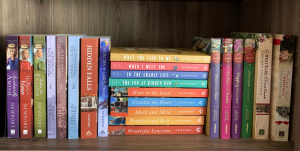I make no apology for the fact that I go to the library a lot. In fact, its half-mile proximity to my home was an appealing factor for choosing this house nineteen years ago. In addition to the satisfaction of visiting the home of thousands of books, it makes a nice gentle walk in fine weather.
On my way out of the library, whether I’ve checked out books or was just there to write in a peaceful place, generally I stop by the Friends of the Library store on the way out and half a look around.
Usually I am not looking for active reading—I did just come from the main library, after all. What I look for are older books with interesting photographs that I can pick up for two dollars. I have a visceral response to the photographs—the facial expressions, the moods, the scenery, the layered stories they can tell with a still-life image of a particular moment. Something about a photograph makes me feel as if I’m stepping into another time and place.
When I was writing a Depression-era story, for instance, I struck gold with a book full of photos of the time and explanatory text. (Hope in the Land, the next in the Amish Turns of Time series, will release April 1, 2016.)
Once I picked up several books about the Civil War. Since photos from that time are among some of the earliest available, I find them especially interesting. We don’t have to imagine what the national experience was like; pictures chronicled everything. Perhaps someday I will write about this time.
My latest find was about Main Streets of America. Pictures and pictures and more pictures.
And I haven’t felt my Midwestern roots so deeply in a long time.
The book was divided into a half dozen broad geographical areas of the United States, but my goodness, I didn’t have to read the captions to know when I was looking at small town streets from the Midwest.
I was home.
I’ve lived happily in the Pacific Northwest and in southern California. My mother is from the South, and we used to visit my grandparents there. For nineteen years I’ve lived in Colorado and am quite fond of this region.
I still have family roots in Illinois, though, and whenever I visit, I recognize that this is where I came from. The architecture of towns that sprang up around the same time. The predominant building materials. The palette of the vegetation. The store signage. The water towers, of course.
So you can take the girl out of the Midwest, but apparently you can’t take the Midwest out of the girl.
Stirred-up memories of where they came from are not positive for all people. I realize that. If thinking about your origins causes pain, I hope that where you are now brings you joy. And if life has taken you far and wide from where you started out, I hope that you have opened your heart to new belongings.
A place of belonging, whether where we start out or where we end up, is nourishment for the soul.





